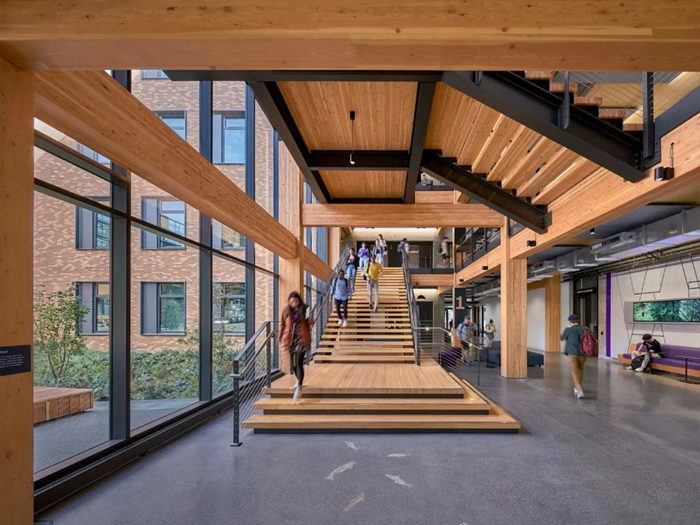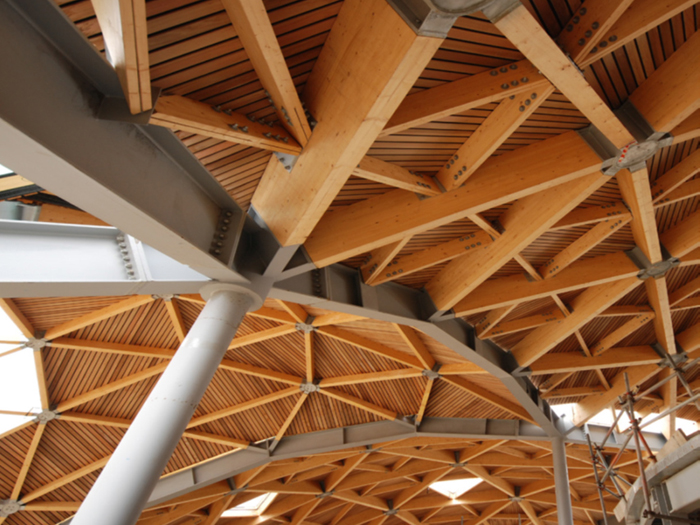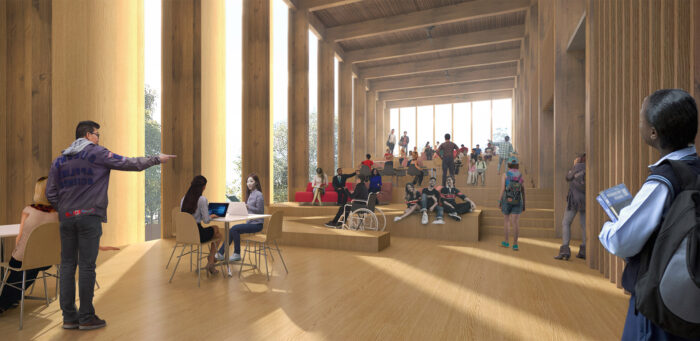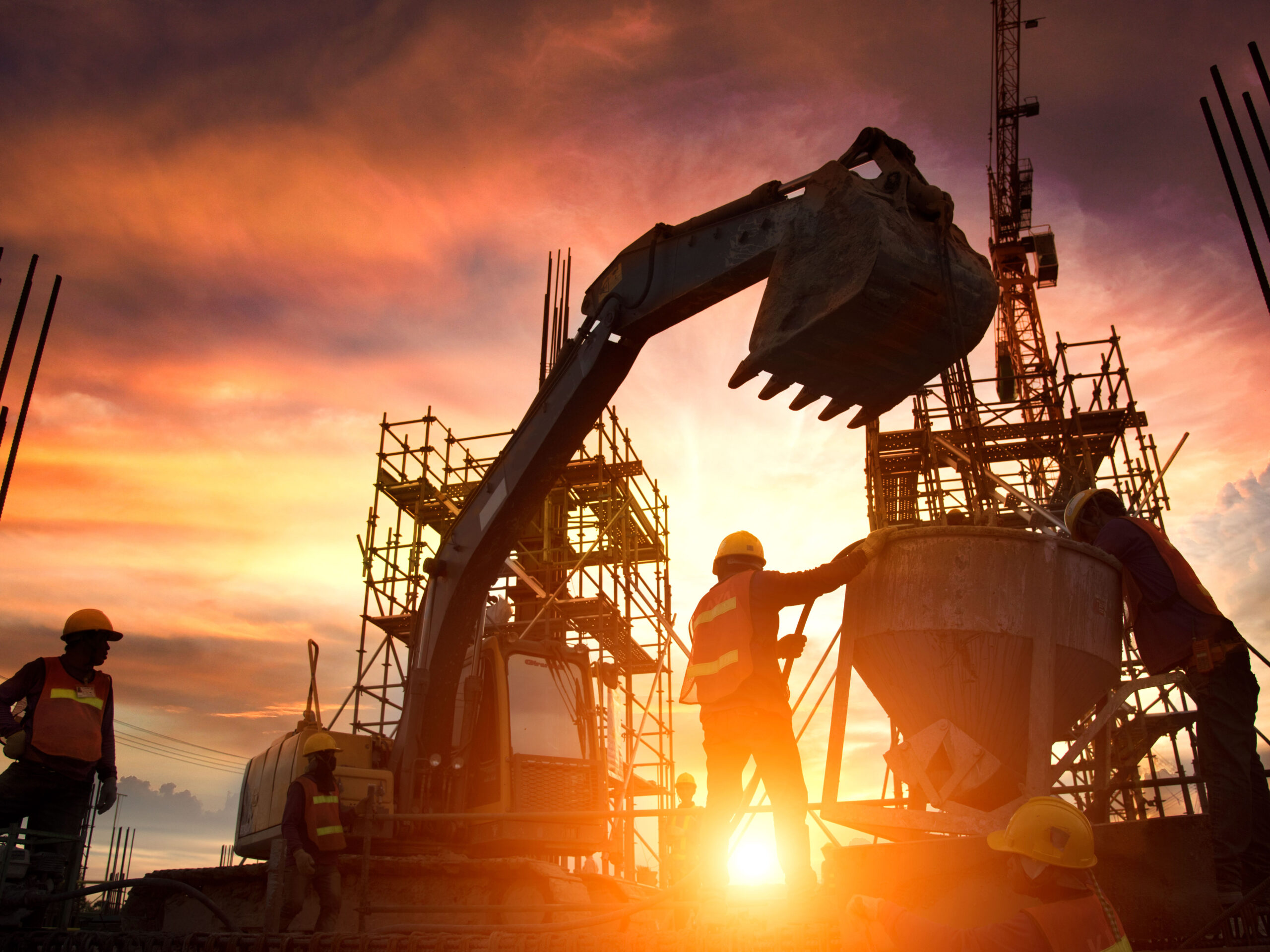Mass Timber’s Resilience Makes It an Increasingly Popular Choice — but Are Insurers Pricing Its Risks Accurately?

Any number of complications can arise when a major construction project goes to market. If you’re lucky, you’ll only encounter one or two of them.
When Bryan McGann, manager of insurance and risk at Queen’s University, sought coverage for a new student hub for its campus in Kingston, Ontario, he seemingly encountered all of them.
For one thing, it was an expensive project — an architectural showpiece combining double-height curtain walls, a sloping cantilevered floorplate, limestone masonry and an interior with soaring ceilings. For another, it included connections to and renovations of historic buildings in a densely populated and highly trafficked area of campus. Then there was the fact that it was hit with pandemic-induced supply chain issues that inflated total cost by about half.
This wasn’t McGann’s first rodeo; he knew how to manage each of these risks and keep the project insurable. Even so, he was surprised that, despite all these hurdles, the cost to insure was ultimately determined by one seemingly insignificant detail: the inclusion of mass timber.

Bryan McGann, manager, insurance and risk, Queen’s University
“To put it into perspective, the overall value of heavy mass timber in this project was around $1.6 million of an $80 million to $90 million project,” McGann said.
Even so, this “very small percentage of the overall project really dictated the entire experience of the rate, the capacity available in the market and the number of insurers that were willing to even come to the table,” he said. “The overall underwriting process was elongated by at least a few months, as the information-gathering part of the underwriting process was very, very thorough.”
A Brief History of Timber
We’ve been building homes with wood since our caveman days (that’s how we stopped being cavemen), but wood-framed multistory towers were virtually unheard of until relatively recently.
Mass timber has existed in one form or another for over a century, said Nick Milestone, director of project execution at Mercer Mass Timber, who has been working in mass timber construction in the UK for nearly 20 years.
But it wasn’t until the 1990s and the invention of cross-laminated timber that mass timber was rediscovered. Austria, Germany and other parts of Central Europe with a history of timber production were the first to explore its potential.

Nick Milestone, director of project execution, Mercer Mass Timber
“Around 2008 or 2009, it started venturing over to our shores,” said Milestone. “And the next thing you know, the UK has gone, ‘We’re going to start doing nine-story residential developments in solid wood as an alternative to concrete.’ When climate change was becoming real and on-radar, we were looking for alternative forms of structural build systems.”
Mass timber caught on in North America at roughly the same time. “You’ve got an abundance of resource in Canada, the Pacific Northwest,” Milestone said. “And then it was just a case of a few North Americans going over to Europe, finding out the technology, bringing it back. I think the huge turning point was in 2016, the inaugural international mass timber conference.”
North American initiatives like the U.S. Softwood Lumber Board, WoodWorks, the American Wood Council and Think Wood quickly threw their support behind the technology. “It only takes a few projects,” Milestone said, “then all of a sudden, there’s an explosion.”
As more architects and developers have seen what mass timber can do, it’s fueled more interest, kicking off a virtuous circle of new and ever more ambitious projects.
This growing interest also spurred the release of an updated International Building Code in 2021, one that tripled the maximum number of stories and total square footage, and these proposed revisions are still being adopted locally. Wood-framed towers now reach heights of up to 25 stories.
Material Benefits
While solid wood beams are limited by the size and strength of the trees that produce them, mass timber is a product engineered for size and strength, typically by layering multiple sheets of wood together with glue to create beams far more massive than a single tree could produce, and far more resistant to splitting.
Two of the most common forms of mass timber (and there are many) are glulam and CLT. Glulam (glued laminated timber) can be used to form beams and columns strong enough to replace steel supports, while CLT (cross-laminated timber) is used to create sheets that can replace concrete slab floors and walls. These and other forms of mass timber can be combined with each other and with other materials.
And the benefits are clear. “It looks like mass timber comes in with around a 70% reduction of carbon compared to any other type of building material — steel and concrete, particularly,” said Cheri Hanes, head of innovation and sustainability, North America construction, AXA XL. “And as an insurer, it’s really well aligned with our purpose, which is to act for human progress by protecting what matters. There’s not much that matters more than having a habitable planet.”
Besides sustainability, mass timber can offer financial benefits: “There are cost savings — sometimes, not always, but when there are, it’s related to the fact that the buildings are lighter, so the foundations can be smaller, and that can save a good portion of money,” Hanes said. “There’s less labor to place it, and that saves money. There’s an improved [construction] schedule, with a quicker time to return on investment and shorter time for financing.” (Milestone estimates a savings on construction timelines of 20 to 25%.)
That’s not to mention that mass timber has the beauty of natural wood. Architects love it for its warmth and ability to show off massive spans — they often leave it visible, saving money on interior finishes. Its biophilic properties are a hit with buyers, too, potentially commanding higher rents.

Architects enjoy working with mass timber for its sustainability, its ability to support long spans and its natural warmth and beauty.
The Tradeoffs
Mass timber’s benefits come with a few tradeoffs — and while they’re not insurmountable, they need to be taken into consideration.
One of the great advantages of concrete is that it can be mixed on site, making it easy to transport. That’s not the case with massive timber beams. Because they’re manufactured to very high tolerances, they require specialized production facilities that are seldom near a build site, and are often overseas.
As a result, long-distance shipping could introduce new liabilities, and even site access can be tricky: Trucks carrying beams with pronounced curves or lengths up to 138 feet may occupy multiple lanes of traffic or be unable to make sharp turns, necessitating road closures or unconventional forms of transport.
Insurers are also likely to demand a crew of contractors and builders who have experience working with the material — which can be a challenge, given its relative novelty. Besides being new to most construction crews, mass timber must be assembled to more exacting specifications, especially when it’s combined with other materials.

Cheri Hanes, head of innovation and sustainability, North America construction, AXA XL
“How do you select someone to subcontract that to when there may not be anyone in a particular market who has done it before?” Hanes said. “Some manufacturers partner up with installers and the subcontracting happens that way — they have an installer they like, and they travel with them. There may also be local subs that do similar work, a trade that requires a lot of cranes … It could be steel; in a union environment, maybe it would be the carpenters union.
“And then some general contractors decide to train internal forces to do it, at least on the first go-around. And I love that approach, because then you have these six, eight people who are internal to your company who really know how this stuff goes together. Even if you decide to subcontract in the future, you’ve got some subject matter experts that really, really get it and know what the challenges are.”
Milestone agreed: In his experience, “steel erectors or steel installers were the best people to put mass timber buildings up, because they know how to lift, they know how to pick, they know how to put steel structures together. Putting up a mass timber structure is pretty identical … You just make slight adjustments to the lift and attachments, and on protective care during construction.”
Local permitting bodies like code officials and fire marshals may be just as unfamiliar with mass timber, and so may require more detailed explanations and longer permitting times. As with many of the challenges of working in mass timber, the solution may lie in a proactive approach:
“I’m married to a retired fireman,” Hanes said. “If there was a mass timber project going up in his jurisdiction, he would absolutely want to take his crew out there and show them: ‘Here’s what’s happening; here’s what we’ll do; here’s how you access.’ And I think people underestimate how interested most fire departments are in coming out to their sites and having a look around.”
Safety First
The issue of fire brings us to the big question on everyone’s mind: How safe is mass timber frame construction? Isn’t a timber building at much greater risk of burning down than a concrete or steel-framed one?
The short answer is “No, not really.” Mass timber can burn — it’s still wood, after all — but completed mass timber buildings are not a significantly greater fire hazard than steel or concrete ones, and they’re much safer than typical wood-framed structures.

Mass timber beams can be combined with other materials, but working with the material requires specialized expertise and a high degree of precision.
“Fire is a bit of an urban myth when it comes to mass timber,” Milestone said. When the surface of a mass timber beam is scorched, it creates a layer of char that doesn’t readily burn; this maintains the structure’s integrity for a surprising amount of time. For the same reason, you often see charred tree trunks still standing (albeit defoliated) after a major wildfire.
“Take a steel column,” Milestone said. “Visually, it looks like ultimate strength, but in a fire, left unprotected, steel can effectively yield and go plastic in 60 minutes. A solid glulam column — and I’ve been testament to this in a building that I once built — the columns stood for 14 hours, because it just charred itself and remained intact.”
Furthermore, as Hanes explained, mass timber benefits from “the fact that the adhesives used, especially in North American-produced mass timber, are absolutely created specifically for this application so they won’t delaminate in case of fire. And they are designed not to delaminate if they get wet.”
In fact, the steel connectors used to join timber beams together are often hidden inside the timber frame to protect them from extreme heat and prolong collapse. By some estimates, a mass timber structure can withstand conflagration for 90 minutes; by contrast, the typical wood-framed single-story building stands for just 17 minutes. “North America loves timber stick frame,” Milestone said, “but they’re matchsticks.”
So while its surfaces may burn, mass timber boasts surprising structural resilience. With the addition of fire mitigation systems like sprinklers and extinguishers, its risk of a total inferno compares well with steel and concrete.
That’s not to mention mass timber’s resistance to earthquakes and high winds, where testing has shown that mass timber performs very well. Milestone predicts that mass timber will soon edge out wood-framed construction — “not for structural reasons, more for insurance reasons, because you’ve got a more robust building.”
It’s worth noting, however, that the above pertains to completed structures — buildings that have been topped off, sealed inside a building envelope, and fitted with smoke detectors and sprinkler systems. Structures mid-construction and shipments of unassembled mass timber materials are more vulnerable to damage from fire and water (and even graffiti), and so require more protection during their journey from factory to ribbon-cutting ceremony.
These measures are easy enough to put into place, but they do require careful advance planning. Keeping timbers away from water and humidity than can warp and stain is important not only to protect the materials but also to keep insurers happy.
“It definitely requires robust moisture protection during storage and during the placement of the material — the sequencing is very important,” Hanes said. “And a water management plan for every type of water is necessary. If there’s going to be a rain event, you need to have people ready with squeegees to get that off the material. Wood can get wet, but it also has to dry — it can’t be left to soak in water. That has to be managed carefully, and one of the things we definitely look for is a robust water management plan.”
Then, of course, there are those unforeseeable hazards inherent to any construction system lacking a long history of claims. “Those unknown unknowns can really jump up and get you,” Hanes said, “and it speaks to the need to work with experienced partners to the extent that that’s possible.”
Running for Cover
If there’s one thing insurers loathe, it’s unknowns — and that may explain why the cost to insure mass timber construction comes with some sticker shock. One result is that additional measures to safeguard a mass timber project fall to risk managers like McGann.

Susannah Davis, vice president, national construction and surety, Marsh
“At this time, the North American insurance market does not have a strong level of comfort with mass timber construction, as we also don’t have a long history with the material to learn from,” explained Susannah Davis, vice president of national construction and surety at Marsh, who worked with McGann to secure coverage for the Queen’s student center project.
“On any construction project, but especially when working with mass timber, insurers will be highly invested in the risk management protocols that the contractor will be instituting,” Davis continued. “For mass timber projects, this would include … a fire protection plan and moisture management plan. There is also special attention paid to the manufacturer of the mass timber product and the contractor’s prior experience with this material.”
This conforms to McGann’s experience. “When it came to underwriting, I feel as though there was a really heavy scrutinized process. Underwriters wanted to know everything and anything, as they would, about this project,” McGann said. “We’re talking, obviously, safety plans; they want to know about hot works; permits; they want to have quality assurance; quality control … Every part of the project was really heavily underwritten. It didn’t come as a surprise, because of the nature of it, [but] the level of scrutiny really did go up a notch.”
McGann’s takeaway was that while mass timber frame has the potential to shorten construction timelines, the additional planning it requires elongates the timeline to insure.
“Anytime I’m involved in a design and construction meeting for a future project, my first question is, what is it going to be made out of? What’s the COPE information, what are the construction details?” McGann said. “Because really, that’s going to dictate the experience when it comes to setting up the insurance program for the project.”
Today, when he hears the words “heavy mass timber” uttered, McGann’s immediate response is “OK, we’re taking a right turn here. These are the expectations we all have to have as we set up this project … Budget expectations need to be realized and discussed well ahead of time, because that was a big sticker shock when it came to the actual policy quotes and binding numbers.”

The new Queen’s University student center, seen here in a digital rendering, is slated to open next spring.
Davis agreed: “It is helpful to be aware of the construction materials early in the process, in order to set the expectation of what an indicative builder’s risk premium and applicable deductibles would look like, and in order to ensure the budget has been adequately set to support both.
“Mass timber will not be rated like non-combustible construction would be, so the resulting premium could be many multiples of what a concrete version of the same would be priced at, with deductibles likely elevated as well. As deductibles will cascade all the way down to the sub trades, there needs to be collective understanding with the entire project team.”
She added, “We further manage the cost to insure by accessing not just domestic insurers but also those in the global marketplace, specifically insurers with European experience and thus a longer history with the material to pull from.”
In addition to bracing for greater cost to insure, McGann said, it’s important to communicate “expectations around how long it takes to achieve something like setting up an insurance program. Something that I’m continually discussing with our design and construction team is the realities of how long that actually takes.
“It’s not like setting up a home and auto policy where you call on Thursday and you have it in place by Friday morning,” he said. “There’s thorough underwriting; there are details that are absolutely necessary in order to make insurers comfortable with the risks at hand. [It’s important to] work with the entire team and make sure that everybody understands what information is necessary and the realities of the time it takes to set up these projects.”
Taking the Next Step
While consumers and even developers could probably benefit from more education surrounding mass timber’s potential, insurers have been monitoring its performance closely, even taking a proactive approach to developing best practices.
For instance, the UK’s Alliance for Sustainable Building Products has developed the Mass Timber Insurance Playbook with input from brokers and insurers like Gallagher, Marsh, Munich Re and Zurich.

Jake Concannon, VP, construction services, Gallagher
Thanks to these insurers’ proactive stance, “acceptance of mass timber is growing in the insurance community,” said Jake Concannon, VP of construction services at Gallagher. At Gallagher, for instance, Concannon has helped to lead “extensive efforts in changing the paradigms around mass timber in the insurance community,” he said, impacting the rates and capacity available in the market as a result.
“For the last few years, we have worked tirelessly to help shift rates, capacity and acceptance amongst insurers and reinsurers around the globe,” Concannon continued. “By utilizing our relationships with contractors, engineers, industry experts, developers and others, we have been able to educate insurers on mass timber and the risks associated with it. For years, it was treated as ‘wood frame,’ but we have helped reshape that thinking, which has led to wider support from multiple insurers in the space.”
Speaking from an insurer’s perspective, Hanes acknowledged that the cost to insure mass timber was initially out of line with its safety profile, but as more research is produced, the costs are coming down.
Today, the cost to insure mass timber “is between non-combustible concrete or steel and light wood framing,” Hanes said. “It’s clear that mass timber is superior to light wood framing in terms of combustibility, but it’s still more combustible than steel or concrete construction, and that does factor into insurance rates. It comes in somewhere in the middle.”
And as more data becomes available and the performance of mass timber is better understood, the cost to insure will continue to evolve. “This got really bad for a while — for a while, [mass timber was] being priced as if it was light wood frame, because it was wood,” Hanes said. “We recognized internally that that wasn’t right. And that’s why we went on to develop coverage for mass timber that was specific to mass timber.”
Meanwhile, insurers will continue to scrutinize the details of mass timber projects closely. “What we need to see to get comfortable with it is experienced contractors that have successfully delivered these types of projects in the past — that they’re using proven materials that are supplied by experienced manufacturers,” Hanes said. “And we want to see that projects are going to employ the monitoring technology and fire suppression systems to complement the contractors’ risk management programs.” &










